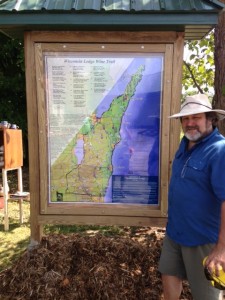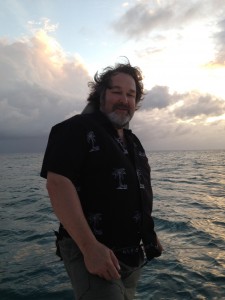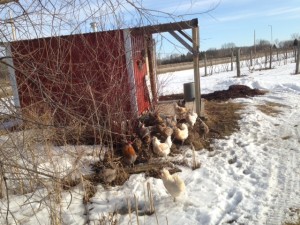Trout Springs Winery: Less Carbon Equals More Cash
Here at Trout Springs Winery (TSW), we once burned coal, wood and fuel oil to heat our winery and home. For years, these were the most economical sources of energy.
Then, during the fall of 2014, after two years of researching wind and solar renewable resources, we decided to retrofit TSW’s two main buildings to new geothermal systems.
Converting to Geothermal Energy
Our plan involved constructing two geothermal systems. One would take care of the Winery and one would take care of our adjacent home.
Part of the motivation for geothermal is the cost of heating in central Wisconsin. We were spending upwards of $10,000 per heating period. This expense was not sustainable for us.
In addition, we’re are not getting any younger. Splitting wood and shoveling coal is good occasional exercise, but I’d much rather spend my time working at the Winery.
So we chose a contractor with over 30 years of experience to install the systems: Tom VanKauwenberg of Van’s Refrigeration, Oneida, Wisconsin.
It took nearly 20 months to complete, as there was extensive excavation and retrofitting involved The new geothermal system now provides air conditioning in addition to heating.
The system for the winery heats our domestic hot water, loops to our heating coils, and also gives us air conditioning throughout the winery. The system for our adjacent home gives us air conditioning, heats our domestic hot water, the hot tub, and heats the coils to our heating system
In addition to the cost savings, we no longer burn:
- Three tons of coal per month equal to 11,220 pounds of CO2,
- Three full cords of wood per month equal to 22,176 pounds of CO2,
- 100 gallons of fuel oil per month equal to 2,240 pounds of CO2.
In total, our total carbon emissions dropped a staggering 68%. We went from releasing 35,636 pounds of CO2 each month to now producing 11,220 pounds per month in the winter, and under 8,000 pounds a month in the summer.
This transformation has been amazing both economically and ecologically. We have saved an average of $6,000 annually with our current geothermal system.
I calculate that the geothermal system will pay for itself in just over four years. I’m certainly no ‘tree-hugger”, but the economic incentives, coupled with the ecological improvement, made this decision a ‘no-brainer”.
Along with the cost savings, we also now have central air conditioning in both our home and winery.’ We have also incorporated a duct sealing product that has saved us over one ton of loss of air in our existing leaky ductwork. This product was installed by R.A. Heating and Cooling, Evansville, Wisconsin.
Duct sealing makes sure the conditioned air goes where you want it. That puts another huge dent in our carbon footprint. Following all of these improvements, we qualified as Green Professionals in Wisconsin’s Green Masters Program.
New Egg Laying Pest Reduction Program
We have also reduced our insecticide spray program at TSW by incorporating a flock of 30 chickens in the vineyard to reduce insects naturally. These Americana chickens eat any insect that moves in the vineyard, and in return they lay blue eggs that we sell in the winery.
People think they lay blue eggs from eating the grapes and it makes for a great story. But this species of chickens lay blue eggs naturally.
Carbon Sequestration in the Vineyard
In addition to the improvement to our home and winery, we have also incorporated techniques for carbon sequestration in our five acre vineyard.
Studies have shown that long term storage of carbon can be accomplished through non-disturbance of soils, and intake of carbon through vines through photosynthesis.
Approximately two kilograms of organic soil carbon can be sequestered for one foot of soil depth.
And 1.87 kilograms of carbon per vine can be sequestered. After 21 years of vines in place, this value increases to 3.60 kilograms of carbon per vine.
Not disturbing the cover crop between the rows of grapes and allowing the vine canopy to grow vertically can make a tremendous difference on your carbon footprint without affecting your crop.
These techniques work best with hedge pruning, I’ve found. A common practice in viticulture is to work up the soil between rows and prune back excessive vine growth.
This has led to a yearly carbon sequestration of just under the equivalent of one ton of CO2 per year in our five acre vineyard.
Branch River Trout Hatchery Goes Green Too
At TSW, we’ve also achieved minimum water usage in our Class A private Trout Hatchery (Branch River Trout Hatchery.)
Over 30 years ago, our peers said we did not have enough water for a trout hatchery. But we have proved our critics wrong over time.

Steve DeBaker next to a sign for the Wisconsin Ledge AVA which he successfully petitioned to the TTB.
We have an artesian well on our property that produces about 30 gallons per minute. In the design stage of our raceways, we incorporated a gravity flow through system to utilize all water flowing from one raceway to the next, thereby saving water from just a single pass system through each raceway.
All 30 gallons per minute passes through five different raceways through elevation changes, and gravity flow from just one pump. This was something industry leaders said could not be done.
During 2012, Branch River Trout Hatchery was recognized by the US Department of Agriculture as the largest private producer of Brook Trout in the state of Wisconsin. Guess it can be done!
Adding Up the Benefits
All of these measures add up to significant savings both economically, and ecologically. And as we say at TSW, “Green means less carbon and more cash.”
Too often, people throw up their hands, and say,”What can I do, I’m just one person?” But if we all do just a little, we can make a huge change in what kind of world we live in. More importantly, we also change what kind of world we will pass on to our children, and grandchildren.





